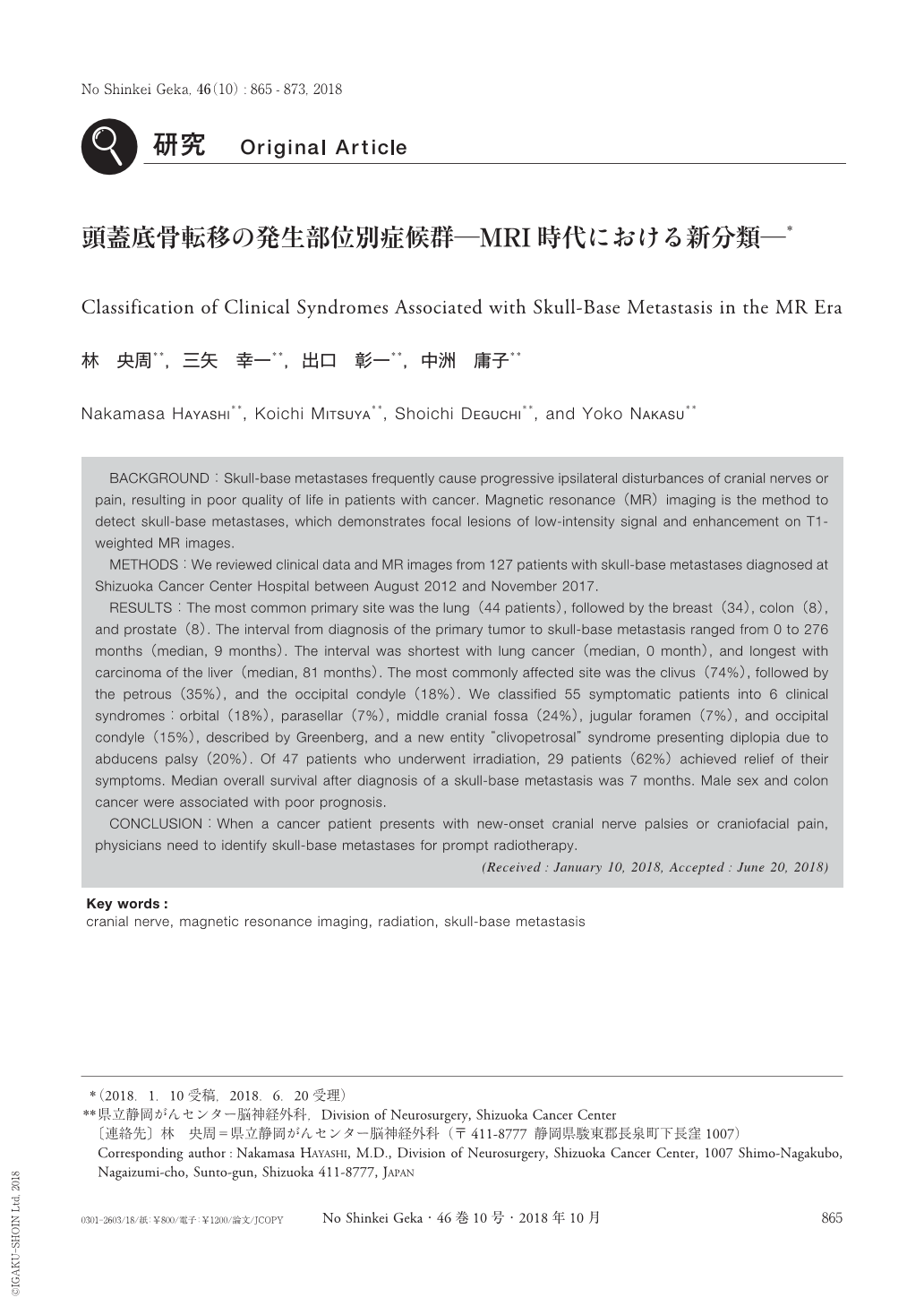Japanese
English
- 有料閲覧
- Abstract 文献概要
- 1ページ目 Look Inside
- 参考文献 Reference
Ⅰ.はじめに
がん治療の目覚ましい進歩によってがん患者の生命予後が延長するに伴い,頭蓋内転移の診断と治療が重要な臨床課題と位置づけられるようになってきている9).同時に頭蓋内病変の評価として行われるMRI検査において,症候性あるいは無症候性の頭蓋骨転移が発見される頻度は増加している7).
転移性頭蓋骨腫瘍自体が生命予後に関与することは少ないが,頭蓋底骨に発生した場合には,その発生部位に応じて疼痛や脳神経麻痺を中心とした特徴的な症候が出現する.1981年にGreenbergらは,X線およびCT所見と症状・脳神経障害に基づいて,頭蓋底骨転移に伴う症候群を発生部位に応じて5つに分類した4).これらの症状は患者の生活の質(QOL)に与える影響が大きく,早期発見による治療の重要性が指摘されている5).
頭蓋底骨転移の診断においては,病変の広がり,脳硬膜や脳神経との関係を把握する上でMRIが有利である6).T1強調画像では転移によって骨髄の脂肪による信号が消失することを反映して,左右非対称な低信号領域が観察される.脂肪抑制造影T1強調画像を用いることにより,骨髄の脂肪信号が抑制されることから,より明瞭に骨転移巣が描出される5,7).
本研究では,頭蓋底骨転移発生部位をMRIで詳細に分析して,外転神経麻痺による複視を主症状とする斜台・錐体骨部骨転移が高頻度に存在することを明らかにした.これはGreenbergらによって提唱された5分類では抽出されていなかったものであり,斜台・錐体骨部骨転移によって外転神経麻痺による複視を呈するclivopetrosal syndromeを新たに加えた6分類を提唱した.また,頭蓋底骨転移が好発するがん種を抽出して,臨床的特徴・発生部位の特徴を比較検討するとともに,生存解析を行った.
BACKGROUND:Skull-base metastases frequently cause progressive ipsilateral disturbances of cranial nerves or pain, resulting in poor quality of life in patients with cancer. Magnetic resonance(MR)imaging is the method to detect skull-base metastases, which demonstrates focal lesions of low-intensity signal and enhancement on T1-weighted MR images.
METHODS:We reviewed clinical data and MR images from 127 patients with skull-base metastases diagnosed at Shizuoka Cancer Center Hospital between August 2012 and November 2017.
RESULTS:The most common primary site was the lung(44 patients), followed by the breast(34), colon(8), and prostate(8). The interval from diagnosis of the primary tumor to skull-base metastasis ranged from 0 to 276 months(median, 9 months). The interval was shortest with lung cancer(median, 0 month), and longest with carcinoma of the liver(median, 81 months). The most commonly affected site was the clivus(74%), followed by the petrous(35%), and the occipital condyle(18%). We classified 55 symptomatic patients into 6 clinical syndromes:orbital(18%), parasellar(7%), middle cranial fossa(24%), jugular foramen(7%), and occipital condyle(15%), described by Greenberg, and a new entity “clivopetrosal” syndrome presenting diplopia due to abducens palsy(20%). Of 47 patients who underwent irradiation, 29 patients(62%)achieved relief of their symptoms. Median overall survival after diagnosis of a skull-base metastasis was 7 months. Male sex and colon cancer were associated with poor prognosis.
CONCLUSION:When a cancer patient presents with new-onset cranial nerve palsies or craniofacial pain, physicians need to identify skull-base metastases for prompt radiotherapy.

Copyright © 2018, Igaku-Shoin Ltd. All rights reserved.


